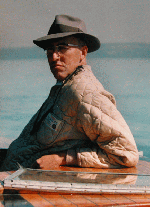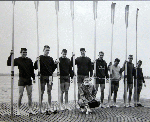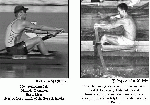Yale Versus Cornell and Navy During the Mid-1950s - Part V
The 1957 Season
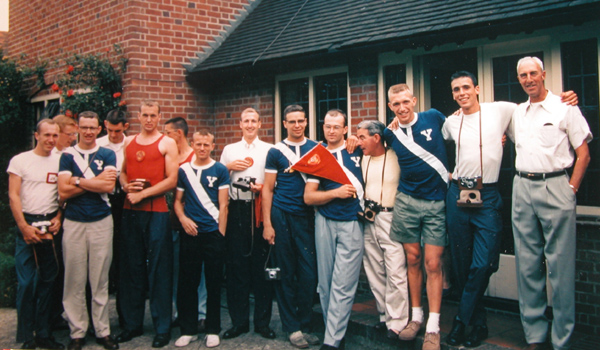
Cornell stroke Phil Gravink: "Stork was a quiet man, but you knew when he was trying to get into your head.
"Todd Simpson (now deceased) and I each were married in the summer of '56 after the Olympic Trials.
"When we hit the water in mid-March of '57, Todd and I found ourselves in the second or third boat. It was the first time in four years I had been out of the first boat stroke-seat. It was almost the same for Todd in the 4-seat.
"We played musical chairs for three weeks, but all of that time the two of us were never back in our old seats. On any given quarter- or half-mile time trial, any of three boats might win.
"It was hard to hide our thoughts from our new brides that Coach might have suspected that our priorities had changed.
"Who knows what his thoughts really were?
"Finally, about ten days before the Goes Cup, our first race in late April, he pulled our boats together out in the lake and put Todd and me back in our old seats, and Bob Staley, our frosh 2-man, was back in his old seat. He had worked hard, mostly in the Jayvee boat, for two years.
"We had one or two short time trials that afternoon, and our boat won by open water.
"Our '54 championship Frosh Crew was now all back together, save for Ben Park, who had left crew to apply to med school.
"Sadly, just a few years later Ben died as a military doctor in a helicopter crash in Korea."128
The 1957 season represented an opportunity for Cornell to avenge their bitter Olympic Trials loss to Yale.
For Yale it represented the challenge of replacing half the Gold Medal crew.
John Cooke: "Note that in 1957 the Cornell Crew had essentially been together for a full four years. We had the major losses of captain and super-tough Tom Charlton at bow, the highly experienced and picture-perfect oarsman 6'6" Dave Wight at 2, tall, rangy and powerful 6'7" 217-pound Charlie Grimes at 5, and tough, dedicated 'Essy' Esselstyn at 6.
"The Olympic Finals had been on 27 November 1956, and although we had trained all fall on our home course, we had had little contact with the rest of the Yale squad.
"Thus, when the crews hit the water again in late February, 1957, the returning four oarsmen and coxswain had never rowed with any of the other Yale undergraduates, and a major restructuring of the Varsity Eight had to be accomplished in relatively short order.
"We selected for the 1957 Yale Varsity some very good oarsmen, notably Reed Rubin at 6-man, but it clearly was not the same boat as in 1956."129
The first meeting of the 1956 rivals went to the Big Red.
Cooke: "We had a bad day against Cornell on a rolling Lake Cayuga. We never could get it together and had trouble handling the swells."130
Time Magazine: "The Big Red crew from Cornell stuck with Yale's Olympic champions all the way down the Olympic course (2,000 meters) on Princeton's choppy Carnegie Lake, but Yale's two feet of lead seemed too much for the Big Red to erase.
"Then, ten strokes from the finish, Cornell's all-senior eight found strength for a final spurt. Their shell slid across the line inches in front to win the heavyweight sprint championships.131
Forty-nine years later, the Eastern Sprints, the second 1957 meeting of Cornell and Yale, could still bring tempers to a boil.
Yale's Cooke: "At the Eastern Sprints in Princeton, we rowed well and we crossed the line in what we believed was a very close win over Cornell.
"There was no finish line camera, but we were convinced we had won. We celebrated, and Cornell quietly hung their heads.
"We sat there at the finish line for probably ten or fifteen minutes until the judges announced that Cornell was the winner!
"Another example of the bias against Yale? The rumor was that a Cornell judge and two Navy judges voted for Cornell, while a Princeton and a Harvard judge chose Yale."132
Yale freshman coach Art Gilcreast: "We beat them, period. I remember looking at film of the Sprints with Jim Rathschmidt, he pointing out that in the body of the race Yale was understroking Cornell and moving on them!!!!!!
"Jim was convinced that we were faster - and he was right."133
"Anyway, that Sprints loss was the primary impetus for Yale to travel to Henley in order to meet Cornell one more time."134
So it didn't finish there on Carnegie.
Time Magazine: "No one at Britain's Henley Royal Regatta was surprised that the Yale and Cornell crews had crossed the Atlantic just to continue their bitter private rivalry. Each was out to prove its superiority once and for all.
"Last season, Yale edged Cornell in the Olympic Trials, and went on to win a Gold Medal at Melbourne. This year, the veteran Cornell shell had twice beaten the Olympic Champs."135
When Cornell met Yale in the finals of the Grand, they hadn't forgotten their disappointment at the Olympic Trials of the year before.
The contrast in technique between Cornell and Yale is instructive.
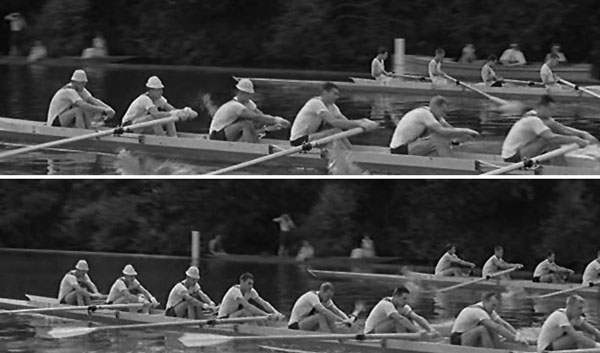
1957 Grand Challenge Cup Final
Cornell Versus Yale
Cornell (near boat): -10°, +30° to -5°, 0-5, 0-10, 0-10, rate 31
Cornell back motion completely overpowered by legs at the catch.
(photo from British Pathe Newsreel, 1495-11, Sport - Henley)
The Yale crew rowed an elegant +30° to -20°, 0-10, 0-10, 0-10.
As can be seen in the background of the photo included in this article, Yale legs were very strong after their concurrent entry.
The first photo captured Yale in the far lane just after their backsplash entry. Legs were approximately one-third of the way down, and backs had swung from an initial +30° only to +20°.
Analysis of the newsreel footage reveals that the continued Yale emphasis on strong legs had led to just a hint of force discontinuity at mid-stroke. As had happened to so many techniques in the past, over time their force application had crossed the fine line to mutant two-part segmented-effort Kernschlag and did not have quite the same swing as the previous year's Olympic crew.
But their pullthrough nevertheless ended with a surging rush to the finish, and though initial back motion was slowed by their strong leg action, the backs indeed began their swing right at the entry.
The second photo shows Cornell's innovation. It was right after the entry, and the legs were already one-third down, but despite the obvious ongoing effort visible in the arms and latissimus dorsi, the back angle remained at +30°, precisely where it had begun.
The rhythm of the two crews was also materially different, Yale's characterized by a steady Rathschmidt recovery leading to an unhurried backsplash entry, and a surging (Kernschlag?) pullthrough with its elegant 50° body arc, Cornell's, characterized by a recovery building in anticipation for an attacking catch that began several inches above the water, and a Schubschlag pullthrough dominated by leg drive and accompanied by only 35° of total body swing.
After more than a century of history, Cornell in 1957 was the first major American collegiate crew to row with concurrent effort but sequential motion.
At Henley, rowing their characteristic, powerful 31 strokes per minute, Cornell powered across the line half a length ahead of Yale, lowering the mile and five sixteenths course record by eight seconds to 6:30.136
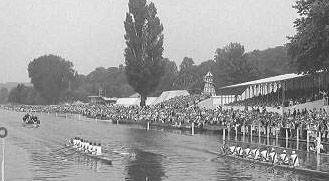
1957 Cornell University Heavyweight Men's Eight
Grand Challenge Cup Final over Yale
Bow Jack Van Horn, 2 Bob Staley, 3 Dave Davis, 4 Todd Simpson, 5 Bill Schumacher,
6 Clayton Chapman, 7 George Ford, Stroke Phil Gravink, Coxswain Carl Schwarz
(photo from British Pathe Newsreel, 1495-11, Sport - Henley)
"Shrugged Yale Coach Jim Rathschmidt: 'I'm afraid we have to admit that Cornell is the faster crew.'"137
Half a century later, the Yale crew remained frustrated about their Henley experience. John Cooke: "I have seen Cornell's very impressive, leather-bound 'scrapbook history' of their 1957 Crew, in which they frequently claim superiority over the Yale Olympic Champions, but with four highly effective oarsmen graduated from that Yale boat, somewhat lacking in veracity!
"There is no doubt in my mind that had Charlie Grimes been sitting in the 5-seat at Henley, Yale would have won, and also would unequivocally have won the Eastern Sprints at Princeton that spring."138
Gravink: "Yale had its Olympics in 1956. Well, 1957 was our Olympics.
"At Henley, we were called things like 'the fastest crew of all times,' etc. I remember a Times [of London] headline that asked 'How can we create a European Cornell?'
"After Henley, we went on to the Continent and set the Lucerne course record at the Internationale Rotsee Ruder-regatta."139

1957 Cornell Varsity the morning after the Grand
(l to r) Spare Jack Meakem, Spare George Bullwinkel, Bow Jack Van Horn,
4 Todd Simpson, 5 Bill Shumacher, 3 Dave Davis, Coxswain Carl Schwarz,
2 Bob Staley, 6 Clayt Chapman, 7 George Ford, Trainer Georges Cointe,
Stroke Phil Gravink, Spare Glen Light, Coach Stork Sanford
(photo from Phil Gravink)
Gravink continues: "Clayt Chapman, our Captain and 6-man, deserves a lot of the credit for our success. He was the team leader for most of the four years, even before he had the captain's title. He continues in that role even today. We now call him Commodore Chapman. He went on to Coach at Cornell and then to manage the ECAC, where he ran the Eastern Sprints and IRAs for over thirty years. In fact, though less formally, he still does.
"There is a sad irony about these two great crews. Yale has lost three140 of their eight to premature deaths and so have we. In the past decade, Jack Van Horn, our bow-man, died of pancreatic cancer, Dave Davis, our 3-man, of early Alzheimer's and Todd Simpson, our 4-man, of hepatitis C.
"Our whole crew and our wives have stayed close through the years, and we now reune every year."141
Cooke: "1958 was a different story. Yale went undefeated, setting records on every course and for every event (except the Boat Race against Harvard, where delays caused by wind and whitecaps forced the race to be held against a strong headwind and against the tide).
"At Lake Carnegie for the Eastern Sprints, while winning by more than a length of open water without sprinting, we set an EARC and course record of 5:54.4 which stood for 13 years.
"That was just a week after we easily won the Carnegie Cup against Cornell and Princeton and set the Princeton course record for the 1.75 miles.
"The 1958 Yale crew was very fast over the 2,000 meters, although, frankly, it was not as 'tough' as the 1956 crew and definitely not its equal over the four miles of the Boat Race.
"Sports Illustrated that year featured the Yale Crew in its pre-season edition with photos and labeled the 1958 Crew as 'the Crew to Beat.' Well, nobody could.
"That 1958 crew also included Emory Clark at 5. He and Yale Jayvee teammate Boyce Budd later rowed 5 and 6 respectively in the Vesper Olympic Champion eight in 1964."142
Von Wrangell: "In 1962, Cornell had another fine varsity. They won the IRA.
"That crew had a technique definitely different from my 1948 crew. I believe their legs came on first, exclusively. The back would open up a bit, but their arms were still pretty straight when the legs were all the way down flat.
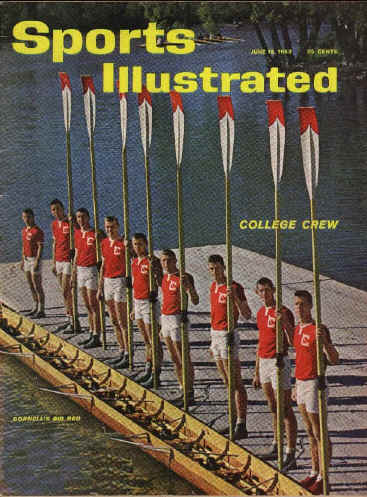
1962 Cornell Crew
Unfortunately, this reproduction is not clear enough to show that stroke-man Bill Stowe is "saluting" the viewer.
(photo from Sports Illustrated)
"In addition, they were a little slower on the release.
"Two years later, the stroke of that Cornell Crew became the stroke of a crew of club oarsmen and college graduates who trained together under the aegis of Vesper Boat Club."143
That Cornell stroke was Bill Stowe, and in joining Yale's Clark and Budd in that Vesper eight, the spirit of competition stoked by Yale and Cornell in the 1950s formed the foundation of the next American Olympic Gold Medal.
The head coaches and a number of members of the Yale, Cornell and Navy crews that competed in the 1956 Olympic Trials have now passed away, but two losses were personal to me.
John remained involved with rowing throughout his life, helping to organize the Eastern Sprints and the Yale-Harvard Race.
After generously and tirelessly assisting me in the writing of my upcoming book, after editing its text and providing many of the illustrations, after challenging me to do justice to his crew, his coach and to his era, John Cooke passed away at the end of 2005 after a short illness. I was privileged to have worked with him, however briefly, and when I got the opportunity to row with the 1956 Yale Crew during their 50th Reunion, John's dear wife, Tori, told me she believed I was rowing in John's place.
I never met Charlie. At the team's 50th Reunion, he was in Paris with his wife, but Charlie spent many hours on the phone with me during the fall of 2006, and when he had answered all my questions, he entrusted all of his rowing files to me.
In January of 2007, Charlie Grimes passed away, leaving instructions that no fuss should be made.
128 Gravink. personal correspondence, 2005
129 Cooke, personal correspondence, 2005
130 Cooke, personal correspondence, 2005
131 Time Magazine, May 27, 1957
132 Cooke, personal correspondence, 2005
133 Gilcreast, personal correspondence, 2005
134 Cooke, personal correspondence, 2005
135 Time Magazine, July 15, 1957
136 Haig-Thomas & Nicholson, p. 120
137 Time Magazine, July 15, 1957
138 Cooke, personal correspondence, 2005
139 Gravink, personal correspondence, 2005
140 now four
141 Gravink, personal correspondence, 2006
142 Cooke, personal correspondence, 2005
143 von Wrangell, personal correspondence, 2005
If you enjoy and rely on row2k, we need your help to be able to keep doing all this. Though row2k sometimes looks like a big, outside-funded operation, it mainly runs on enthusiasm and grit. Help us keep it coming, thank you! Learn more.
Comments | Log in to comment |
There are no Comments yet
| |
- Bont Rowing
- Calm Waters Rowing
- Concept 2
- Craftsbury Sculling
- The Crew Classic
- CrewLAB
- Croker
- Durham Boat Co.
- Empacher
- Faster Masters
- Filippi
- Fluidesign
- h2row.net
- HUDSON
- Live2Row Studios
- Nielsen-Kellerman
- Oak Ridge RA
- Peinert Boat Works
- Pocock Racing Shells
- Race1 USA
- RowKraft
- Rubini Jewelers
- Vespoli USA
- WinTech Racing
- Bont Rowing
- Calm Waters Rowing
- Concept 2
- Craftsbury Sculling
- The Crew Classic
- CrewLAB
- Croker
- Durham Boat Co.
- Empacher
- Faster Masters
- Filippi
- Fluidesign
- h2row.net
- HUDSON
- Live2Row Studios
- Nielsen-Kellerman
- Oak Ridge RA
- Peinert Boat Works
- Pocock Racing Shells
- Race1 USA
- RowKraft
- Rubini Jewelers
- Vespoli USA
- WinTech Racing





